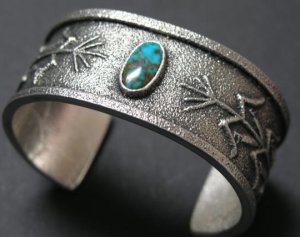We do not currently have any of these items
Tyrone turquoise encompassed a group of mines in the Burro Mountains near the town of Silver City, New Mexico and is associated with the Tyrone Copper mine. It has been said that more high-grade turquoise was produced in this area than any single deposit on record. Turquoise mining in the Burro Mountains had been carried out in prehistoric times and then later by the Spanish. Artifacts, stone tools along with fragments of turquoise and hammers of the local granite were common at the sites. An early mining engineer named Zalenski had noted that after visiting the mines in 1907 there were still traces of fire used to break up the rocks and that one forty-foot shaft still remained though most of the work in the area had been done in open trenches. Kunz, in his work mentions an old Indian burial ground in the area, in which turquoise was found in some form in every grave. Ancient operations helped to determine the locations of some of the more modern claims.
According to Pogue, John Coleman who was locally known as "Turquois John" is credited with the first modern discovery of turquoise in the area. He is said to have discovered some old workings while on a hunting trip in 1875. W.J. Foley and Nicholas Ransome have also been associated with the discovery. The story goes that Foley, of Silver City, was informed by Indian traders that turquoise was present near the town and that ancient workings were known in the mountains. A search by Foley is said to have resulted in the finding of these ancient excavations in the Burro Mountains.
The largest mine in the area was the Azure mine. It was located 10 miles southwest of Silver City and was opened in 1891. It became not only the most famous turquoise mine in the area but the country. Pogue states in his 1915 classic work on turquoise that "It has been operated in modern times more extensively than any other turquois mine in this country, and its stones are the equal of the Persian gems.” In 1893 the famous “Elizabeth Pocket” was entered, which produced more high-grade turquoise than any single deposit on record.” The Elizabeth Pocket was 100 feet long, 40 feet wide, and 40 to 50 feet high. It was thought to be the riches vein of turquoise ever discovered. The cut cabochons were marketed throughout the country with ads appearing in Harper’s and McClure’s magazines. Each gem was engraved with a circle on the back with the ad stating, "None genuine without the ring O on the reverse side.” Azure turquoise, because of its hardness, was guaranteed not to change color.
The material that is available today is usually from older collections. In its high-grade form Tyrone turquoise is a hard, translucent, brilliant or deep blue and today valued highly for it beauty and rarity.
The richness of turquoise found over the centuries in Southwest New Mexico leads one to believe or hope that even today there may be a number of deposits still waiting to be found and claimed in the beautiful but rugged Burro Mountains.
© Copyright 2004 Nevada Gem. Used with Permission.


